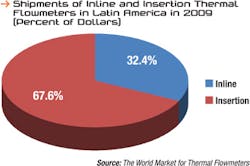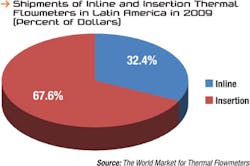In the early 1990s, new environmental regulations began requiring companies to detect and reduce the emission of sulfur dioxide (SO2) and nitrous oxide (NOx) into the air. SO2 and NOx are two principal causes of acid rain. The Environmental Protection Agency (EPA) initiated a program to reduce pollution in the atmosphere. It is possible to determine how much of these substances are released into the atmosphere by combining a measurement of the flowrate with a measurement of the concentration of SO2 and NOx.
In response to CEM requirements, thermal flowmeter companies developed multipoint thermal flowmeters. In many cases, continuous emissions monitoring occurs in large stacks that emit pollution from industrial sources. Single-point thermal flowmeters measure flow at a point, making it difficult to accurately compute flow in a large pipe or smokestack. Multipoint thermal flowmeters measure gas flow at multiple points, and use these values to compute flow for the entire pipe, duct, or stack. Some multipoint flowmeters have as many as 16 measuring points.
While the need for CEM is ongoing, the 21st century has brought new environmental awareness and requirements. This is providing new opportunities for thermal flowmeters to measure emissions in applications such as recovery of landfill gas, monitoring of flue gas, measuring boiler emissions, ethanol refining, and biomass gasification. Expect these types of environmental applications to expand and give new life to thermal flowmeters.
Jesse Yoder, Ph.D., is president of Flow Research Inc. in Wakefield, Mass., a company he founded in 1998. He has 22 years of experience as an analyst and writer in process control. Yoder specializes in flowmeters and other field devices, including pressure and temperature products. He has written over 110 journal articles on instrumentation topics. Dr. Yoder can be reached at [email protected].
About the Author
Jesse Yoder
Jesse Yoder, Ph.D., is president of Flow Research Inc. He has 30 years of experience as an analyst and writer in instrumentation. Yoder holds two U.S. patents on a dual-tube meter design and is the author of "The Tao of Measurement," published by ISA. He may be reached at [email protected]. Find more information on the latest study from Flow Research, "The World Market for Gas Flow Measurement, 4th Edition," at www.gasflows.com.

